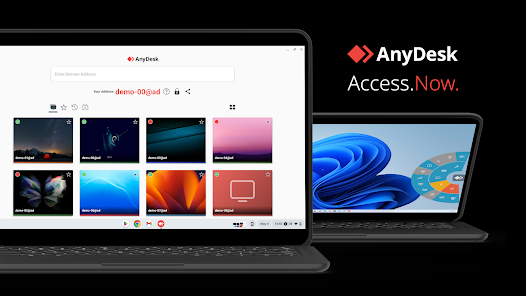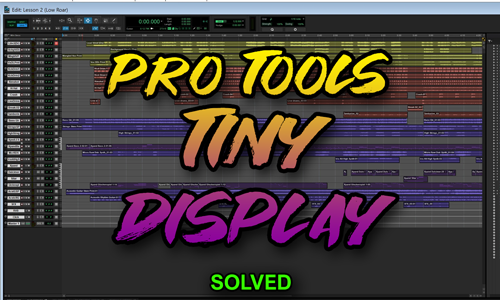Case Study
Pro Tools Display Scaling Fix on Windows 10/11
The Client’s Challenge
I recently worked with a voice-over artist who was finalising his home studio setup. He had invested in a large new TV screen to use as a primary visual monitor, which is a common and effective setup for creative work. However, when he loaded Pro Tools on the new screen, the application window was tiny. While his other Windows applications were scaling correctly, Pro Tools appeared at a fraction of the size, making it unusable.
The client was frustrated because he couldn’t take full advantage of his new monitor and couldn’t read the small text in his recording software. He needed a quick, reliable fix to get his sessions running at the correct resolution and scale.
Session Setup
The support session was conducted remotely, as with all Audio Support sessions. We connected via secure screen-sharing and audio-streaming tools, allowing me to view his screen and quickly navigate the relevant Windows settings while we talked through the issue.
This allowed for a direct, one-to-one consultation, ensuring the solution was tailored precisely to his Windows setup and hardware. Audio Support often uses this approach to troubleshoot complex interactions between hardware, operating systems, and professional software like Pro Tools.

Diagnosis
In modern high-resolution (High-DPI) setups, scaling issues usually point toward a conflict between the application’s internal code and the operating system’s display settings.
I quickly checked his Windows Display Settings. The client had correctly set the system scaling for his new 4K monitor to around 300% to make Windows icons and text comfortable to view. His non-DAW applications were honouring this setting perfectly.
The issue was that Pro Tools, as an older professional application, was not correctly inheriting the display scaling settings from Windows, likely causing it to render at the default 100% scale regardless of the system setting.
The Fix
The solution lay in forcing the operating system to manage the display scaling specifically for the Pro Tools application. This is a common and reliable fix for many older or highly specialised applications on High-DPI Windows screens.
I guided the client through the following steps:
- We right-clicked on the Pro Tools application shortcut on his desktop.
- We navigated to the Properties window.
- Inside Properties, we selected the Compatibility tab.
- From there, we clicked the Change high DPI settings button.
Once in the dedicated High DPI settings panel, we applied the crucial change:
- We enabled the option to “Override high DPI scaling behavior.”
Under the dropdown menu, we selected “Scaling performed by:” and changed the setting to “System.”
Result
Upon saving the changes and relaunching Pro Tools, the application immediately opened at the correct size. Pro Tools was now scaled appropriately, perfectly filling the large new TV monitor and making all the text and controls legible. The voice-over artist could now comfortably view his waveforms and mix window without straining his eyes.
This straightforward system override resolved his immediate technical block, ensuring he could focus on recording and editing his voice-over tracks.
Reflection
This case is a classic example of why holistic technical support is so important. When a program like Pro Tools is tiny on a 4K monitor, it’s easy to assume the fault lies with the DAW or the new screen. In reality, the issue was a specific configuration setting buried deep in the Windows compatibility options.
The fix was fast because I didn’t just look at the Pro Tools software. I examined the entire signal chain: the operating system, the hardware (the new screen), and the application’s interaction with them. This kind of nuanced, one-to-one troubleshooting is what Audio Support provides, moving beyond standard manufacturer support to resolve unique setup conflicts.
Closing Thoughts
Modern high-resolution setups can be a huge asset to any studio, but they often expose hidden compatibility issues with professional audio software. I help musicians and producers worldwide solve problems like this every day. If you’re struggling with Pro Tools display issues or other technical blocks in your setup, I’ll help you find the real cause and get you back to creating.
Recent Reviews
Let’s Get Your System Running Smoothly.
No automated tickets, no waiting queues — just one-to-one help from an experienced music technology specialist. I’ll connect to your system remotely, identify the issue, and guide you through the fix.
I usually reply to enquiries within a few hours during UK weekday daytime.
Once you make an enquiry, I’ll read it personally and reply with initial advice or a link to book a remote session if needed.
For booked sessions, you’ll receive a secure AnyDesk link and we’ll talk via WhatsApp or voice chat. Sessions last up to an hour — long enough to diagnose the cause and apply a practical fix.
Make an Enquiry
I’ll reply personally as soon as I can — usually within a few hours during UK daytime.
Book Your Session Securely Online
You can book your Audio Support session instantly using the secure form below.
Choose a time that suits you — I’ll confirm by email and send remote-access details before your appointment.

Outside the UK? Use the Timezone icon to book in your local time.
- 💳 Session fee: £90 per hour (UK Pound Sterling)
- ⏱️ Availability: Usually within 1–2 days.
- 🗓️ Duration: Each session lasts one hour.
- 🔁 Rescheduling: Sessions can be moved up to 24 hours in advance.
- 🔒 Security: Remote access is one-time only and closes automatically when the session ends.
- 🌍 Timezone: Default times shown are UK (GMT/BST). Use the timezone Icon to set to your local time
You don’t have to keep guessing what’s wrong — I’ll help you find the cause and fix it, so you can get back to making music.
More Case Studies
Recent problems solved for real clients.
AI as a Creative Partner: A Case Study on Using Suno with Cubase
23 November 2025

Client’s Question
How can I use Suno AI with my own acapella from Cubase?
Session Result
Created a custom, AI-generated backing track in Suno from a Cubase vocal export.
Read Full Case Study Report: AI as a Creative Partner: A Case Study on Using Suno with CubasePro Tools Display Scaling Fix on Windows 10/11
23 November 2025

Client’s Question
Why is Pro Tools tiny on my new 4K monitor?
Session Result
Pro Tools display scaling fixed using Windows compatibility override.
Read Full Case Study Report: Pro Tools Display Scaling Fix on Windows 10/11MicroKorg MIDI Sync and Setup Issues in Logic Pro
20 November 2025

Client’s Question
MicroKorg arpeggiator not syncing to Logic Pro tempo
Session Result
Diagnosis confirmed potential hardware or cable fault; alternative routing proposed.
Read Full Case Study Report: MicroKorg MIDI Sync and Setup Issues in Logic Pro
Client’s Question
Can I book an expert to remotely fix my Logic Pro problems?
Session Result
Yes! Audio Support provides remote troubleshooting services. Here are 5 examples showcasing our work.
Read Full Case Study Report: 5 Logic Pro Problems FIXED: Expert Remote Troubleshooting Case Studies